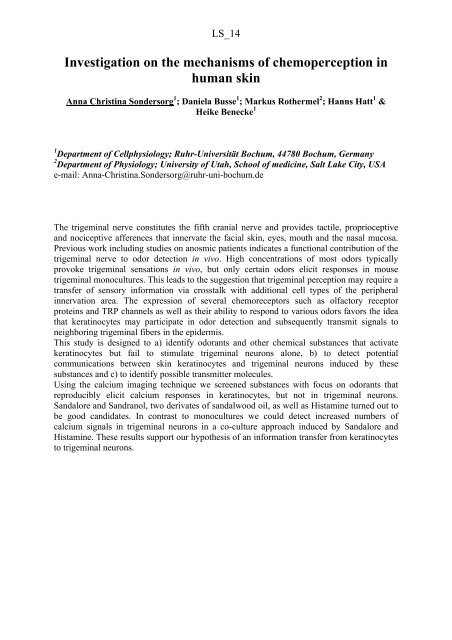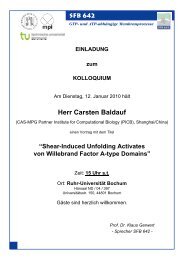Section Days abstract book 2010.indd - RUB Research School ...
Section Days abstract book 2010.indd - RUB Research School ...
Section Days abstract book 2010.indd - RUB Research School ...
You also want an ePaper? Increase the reach of your titles
YUMPU automatically turns print PDFs into web optimized ePapers that Google loves.
LS_14<br />
Investigation on the mechanisms of chemoperception in<br />
human skin<br />
Anna Christina Sondersorg 1 ; Daniela Busse 1 ; Markus Rothermel 2 ; Hanns Hatt 1 &<br />
Heike Benecke 1<br />
1 Department of Cellphysiology; Ruhr-Universität Bochum, 44780 Bochum, Germany<br />
2 Department of Physiology; University of Utah, <strong>School</strong> of medicine, Salt Lake City, USA<br />
e-mail: Anna-Christina.Sondersorg@ruhr-uni-bochum.de<br />
The trigeminal nerve constitutes the fifth cranial nerve and provides tactile, proprioceptive<br />
and nociceptive afferences that innervate the facial skin, eyes, mouth and the nasal mucosa.<br />
Previous work including studies on anosmic patients indicates a functional contribution of the<br />
trigeminal nerve to odor detection in vivo. High concentrations of most odors typically<br />
provoke trigeminal sensations in vivo, but only certain odors elicit responses in mouse<br />
trigeminal monocultures. This leads to the suggestion that trigeminal perception may require a<br />
transfer of sensory information via crosstalk with additional cell types of the peripheral<br />
innervation area. The expression of several chemoreceptors such as olfactory receptor<br />
proteins and TRP channels as well as their ability to respond to various odors favors the idea<br />
that keratinocytes may participate in odor detection and subsequently transmit signals to<br />
neighboring trigeminal fibers in the epidermis.<br />
This study is designed to a) identify odorants and other chemical substances that activate<br />
keratinocytes but fail to stimulate trigeminal neurons alone, b) to detect potential<br />
communications between skin keratinocytes and trigeminal neurons induced by these<br />
substances and c) to identify possible transmitter molecules.<br />
Using the calcium imaging technique we screened substances with focus on odorants that<br />
reproducibly elicit calcium responses in keratinocytes, but not in trigeminal neurons.<br />
Sandalore and Sandranol, two derivates of sandalwood oil, as well as Histamine turned out to<br />
be good candidates. In contrast to monocultures we could detect increased numbers of<br />
calcium signals in trigeminal neurons in a co-culture approach induced by Sandalore and<br />
Histamine. These results support our hypothesis of an information transfer from keratinocytes<br />
to trigeminal neurons.

















